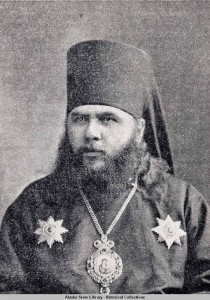Bishop Nicholas Ziorov, head of the Russian Mission in America from 1891 to 1898, is one of the most underappreciated people in American Orthodox history. I am afraid that I have done nothing to help this state of affairs. Back in June, I wrote dismissively that Bishop Nicholas “was a good man, but was also a Russian nationalist whose primary focus was (quite understandably) on the conversion of Uniates to Orthodoxy and their subsequent Russification.”
I based my assessment on a 1967 article by Fr. Alexander Doumouras (“Greek Orthodox Communities in America Before World War I,” published in St. Vladimir’s Quarterly). In the section dealing with San Francisco, Doumouras wrote the following:
It could also be that statements such as the following excerpt from a homily by Bishop Nicholas in 1896, helped to create division between the Greek and Russian parishioners. The sermon centered around the feast of St. Alexander Nevsky. Since it was also the feast of the Russian Tsar, the bishop urged his people to celebrate this particular feast with gratitude in their hearts to the Tsar of the Russian Empire: “It is meet that Orthodox Christians of foreign nationalities — Greeks, Bulgarians, Serbians, Montenegrins, Roumanians, Georgians and others — should, as well as the Russian, celebrate the high feast days of the Russian Church. It is meet — if only out of sympathy with an Empire that followed the same religion. … But this is not enough; all Orthodox nationalities should be inspired in this matter by a feeling of gratitude to the Russian Empire; for the Russian sovereigns have always been zealous guardians and defenders of Orthodoxy all over the world.” It is not difficult to sense that such an expression of Russian nationalism could have antagonized Greek sensitivities and that shortly after the beginning of the twentieth century, a Greek parish came into existence in San Francisco.
When I first read that passage, I had barely heard of Bishop Nicholas, and the idea of him as a mere nationalist got stuck in my head, in spite of all the facts to the contrary. Maybe he was a nationalist, but in the late 19th century, who wasn’t? Regardless, it’s clear that he was more than a nationalist.
The reality is that much of what St. Tikhon is credited with doing was actually accomplished by his predecessor, Bishop Nicholas. Yes, St. Tikhon was a visionary — but in many respects he was continuing, implementing, and expanding upon the vision of Bishop Nicholas. It was Nicholas, not Tikhon, who recruited gifted young men like St. Alexander Hotovitzky, St. John Kochurov, and St. Anatolii Kamenskii to serve in America. Bishop Nicholas ordained Hotovitzky and Kochurov to the priesthood, as well as the great Serbian priest Fr. Sebastian Dabovich. And it was Nicholas, not Tikhon, who first set up special ministries for different ethnic groups, empowering Dabovich and importing talented clergy such as St. Raphael Hawaweeny and Fr. Theoclitos Triantafilides. The flood of Uniates into Orthodoxy began with the conversion of St. Alexis Toth shortly before Bishop Nicholas arrived in America, but it was under Nicholas that the “return of the Unia” really picked up steam.
Bishop Nicholas came in 1891 to a diocese that was reeling from the scandals of Bishop Vladimir, a diocese that had not experienced hierarchical stability since the drowning/suicide of Bishop Nestor Zass in 1883. The diocese in 1891 was centered in Alaska, with only two parishes in the continguous United States (San Francisco and Minneapolis). While not neglecting Alaska (he was a great advocate for the Orthodox natives), Bishop Nicholas oversaw dramatic growth in the rest of the US, with an average of about two new parishes founded every year. Whereas the diocese was tiny and weak in 1891, by the time of Nicholas’ departure in 1898, it was thriving and healthy. St. Tikhon, Nicholas’ successor, was able to accomplish so much because he was a genuinely great man, but also because he took the reins of a diocese made strong by Bishop Nicholas.
After leaving America, Nicholas served as Archbishop of Tver and Kashin, and later Archbishop of Warsaw. He died in 1915.
Nicholas Ziorov may not have been the perfect hierarch, but he was one of the most stable, effective bishops American Orthodoxy has ever seen. He provided strong, sound leadership and a forward-thinking vision at a critical time in our history. His tenure and his legacy warrant further study.
[This article was written by Matthew Namee.]
